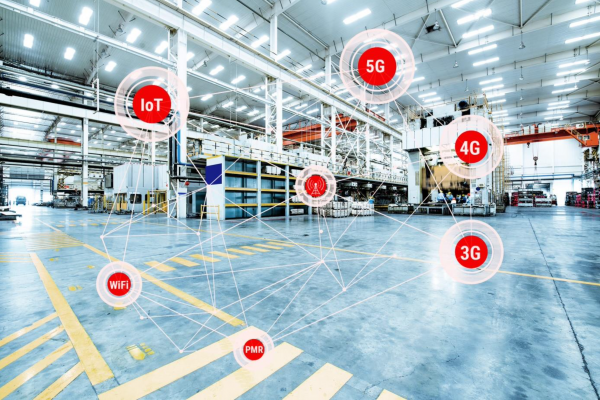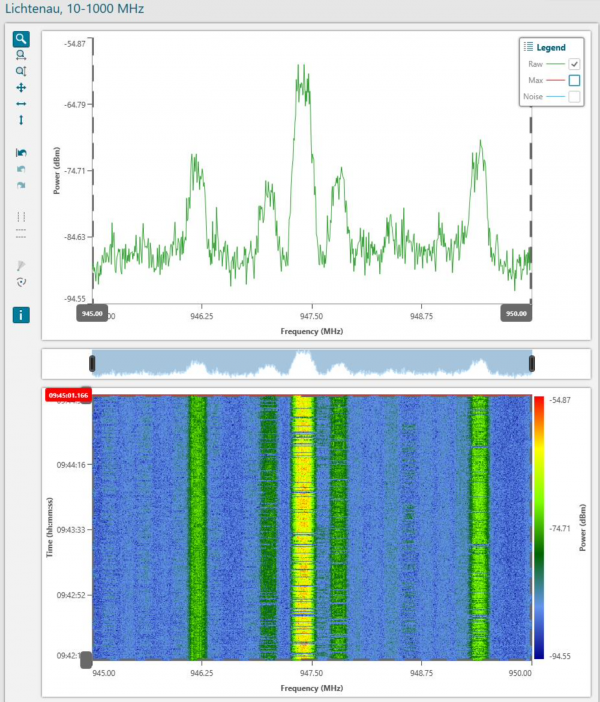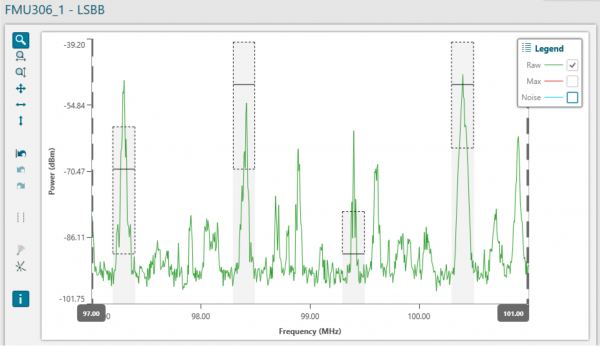Sponsors Article
5G Campus Networks – Essential Means of Production
Image 1: Radio spectrum – users and services (Image: LS telcom AG)
In the industrial environment, 5G will play an important role as an enabler and accelerator of digitalization and transformation to the fully networked industry 4.0. As a pioneer, the government in Germany made it possible to apply for 5G licenses for local campus networks. In the process, it is becoming increasingly clear that spectrum will be considered a particularly valuable infrastructure in the future.
Authors: Roland Götz und Fabian Ludwig
High-quality, secure and reliable network connections are becoming increasingly important. Not least driven by the digitalization of our society and industry, but also by the trends Internet of Things (IoT), Industry 4.0 and machine-to-machine communication, high-quality, secure and reliable network connections are a must. In particular, fast, secure radio data networks are gaining almost explosive importance – and all of these are based on the limited physical resource of radio spectrum. This primarily means:
- Only those who have access to spectrum can or may use it.
- Only with sufficient spectrum can the required data rates be provided.
- Only in clean spectrum can radio be used safely and reliably.
In the global digital society, radio spectrum is a valuable resource for exactly these reasons, a comparably important factor as clean water, uninterrupted power supply or production space.
5G in the starting blocks
In Germany, national 5G frequency spectrum was already auctioned off to the well-known wireless operators Deutsche Telekom, Telefónica and Vodafone as well as the newcomer 1&1 Drillisch in the summer of 2019. The application procedure for local campus networks also began on 21 November. The first 5G signals are in the air and the first 5G-capable mobile phones can already be ordered. The course has thus been set, and there is hardly anything standing in the way of an expansion of the 5G networks. 5G thereby offers – especially for the industry – interesting new technical possibilities and application profiles.
But what is actually special about this generation change is the fact that this time, in addition to the classic licenses for the state-wide mobile network operators (3.4 to 3.7 GHz), the Federal Network Agency has reserved 100 MHz bandwidth (3.7 to 3.8 GHz) exclusively for local, so-called campus networks. For many industrial companies, this is the first opportunity to implement their own individual network tailored to their applications and needs and thus become independent of the operators.
What exactly is a local 5G license?
For your backgroun: There are three main types of licenses for frequency licensing: The general allocation as known from e.g. DECT, Bluetooth or WLAN. Here, a part of the spectrum is made available without a separate application procedure. Only rules and technical limits are specified for the devices. This means that anyone can operate their transmitter, but has neither exclusivity nor protection on the frequency they use.
In the case of the location license, on the other hand, the government authority approves each individual radio installation. Examples of this are radio transmitters. With the third type, the block license, the Federal Network Agency approves a frequency block in a defined area, e.g. in mobile communications a frequency block for an operator exclusively for the whole of Germany. The allocation can take place by auction, by beauty contest or according to the application procedure. The local 5G licenses discussed here are block licenses. They therefore correspond to an exclusive frequency band, limited to the extent of the operator’s own properties. They will be allocated according to the application procedure.
Two alternatives for future 5G users
For industrial companies that want to use 5G in the future, for example to control and monitor their production facilities, this offers two alternatives for the first time. There is still the option of joining a network operator as a service provider: The entrepreneur buys the corresponding SIM cards and thus – as before – rents into their network. The network operator provides this and the agreed services, operates them and takes care of everything. As a new alternative, however, the company can now also acquire its own local 5G campus license and realize its own individual 5G network with the allocation of the license. On the one hand, this will make it independent of the traditional network operators, but on the other hand it will require appropriate capital and expertise.
Why have your own campus network?
But why should a company go the way of its own network, which at first sight seems to be more cumbersome? To bother with questions of conception, planning, procurement, construction and operation? There are several good reasons to apply for your own 5G campus license:
- Exclusive frequency band with full network capacity
Once the application has been successful, the company will receive a licensed frequency band with exclusive frequencies and thus exclusive access to the full network capacity in the allocated frequency block. The company does not have to share these frequencies with other users, the individual use and full capacity of the spectrum is guaranteed. - Individual network design according to own requirements
The license holder can design his network exactly as required for his applications. For example, in terms of the supply, which can be implemented as required – even in the third basement level, in explosion-proof systems or at the last milk churn, which is so often quoted. Your own quality parameters and redundancy concepts can be derived from the individual requirements and implemented to efficiently ensure the required availability. - Data sovereignty and security
Company data remains in the own network and the owner of the license retains control over his sensitive company and production data. Customized IT security concepts are possible to minimize the danger of cyber attacks. - Minimization of downtimes
Power failure times and resulting downtimes can be kept to a minimum by taking appropriate precautions. For critical applications, these measures are usually more complex than for conventional applications. Smaller networks with fewer network elements are usually easier to monitor and can be put back into operation more quickly and without disturbances.
So there are many good arguments why campus licenses are so important for local users and industrial companies as well.
Challenges for the Campus Network Operator
Let us assume that, after due consideration, a company decided to apply for frequencies and was allocated them. Then, at the latest, there are numerous new tasks that have to be mastered as a campus network operator. Since the operator does not offer turnkey network use, you have to take care of the construction and operation yourself. This starts with the design and planning of the network and the reliable radio supply, continues with the procurement, installation and commissioning of the system technology and ends with the actual network operation with maintenance and monitoring. (Image 2)
Since this is usually neither a core competence nor a core business of the licence holder, external help can be included – i.e. all or parts of the service can be “outsourced”. Ultimately, the licence holder must ensure in his own interest that his frequencies are used, managed and protected in an optimal way. Not least to ensure efficient operation and maximise production reliability.

Image 2: Those who decide to build their own 5G campus network have to take care of the setup and operation. (Image: LS telcom AG, Konzeption – istockphoto.com skynesher, Realisierung – istockphoto.com shotbydave, Überwachung & Optimierung – istockphoto.com FARBAI)
How can reliable radio communication be achieved?
In the industrial sector, we are usually dealing with critical applications within the networks, as is also known in the BOS environment, whereby network failures or unavailability can have fatal consequences. The main task and challenge is to ensure an interference-free and non-manipulable radio environment while providing sufficient capacity for all necessary networks, services and applications. However, one should not limit oneself to the new 5G radio network, as it will have to be integrated into an already existing radio environment consisting of WiFi, RFID, Tetra, LoRa and many more. Ultimately, both the new 5G network and all other existing networks and applications must function in parallel without interference from each other. Downtimes are unacceptable and unsafe radio connections must be detected and eliminated as interference. Three main measures are recommended to ensure reliable radio communications:
Concept and planning
First of all a conscientious and professional conception and planning is required. In addition to technically robust planning, especially in the private sector, cost efficiency also plays an important role. This is an aspect not to be underestimated in the demanding industrial environment, with complex structural characteristics. Only rarely will the classic solution – a radio mast with antenna system – be sufficient. Instead, distributed antenna systems and access points will be used in production plants, for example between pipelines, in tunnels, just wherever a stable supply is required.
A wide variety of use cases will have to be considered. Their design and modelling determine the essential network parameters and show “which” 5G network is required: Does a high data rate, highest availability, shortest latency or low energy consumption have priority? More important than ever: design and planning must go hand in hand. Only a well-designed, planned and self-functioning system can ensure reliable radio communication.
Radio inventory
The second measure is to carry out a radio inventory (see Image 3). Neither the medium radio nor its use is visible to the human eye. In order to know what is “on air” on one’s own site, a radio inventory is necessary – comparable to the inventory in a warehouse. The radio inventory shows the actual stock and analyses the current spectrum usage.
For this purpose, appropriate measuring sensors are available which continuously carry out measurements over a certain period of time and record them for subsequent analysis. This is usually done in a weekly or monthly cycle to detect recurring patterns. In this way, it becomes clear what is actually happening on the site in terms of radio communication. Corresponding actions in case of anomalies or active disturbances can be derived from these measurements to ensure a “clean” spectrum before building a new 5G infrastructure. Interference can have many aspects: Consciously or unconsciously, legally or illegally, permanently or temporarily, regularly or randomly, dangerous or harmless.
Frequency Usage Database
A radio inventory is also the basis for the third measure: The introduction of a frequency usage database with coexistence analysis. This database system is the central point where all radio-relevant data and information is brought together and managed. Where are transmitters and radio sensors mounted and installed? On which frequency and with which power do they transmit? Who is responsible for and operates them? Are they legal? In a second step, this database allows interference and coexistence analyses to be carried out. New systems can be simulated and tested for unwanted interactions with existing radio systems in order to prevent interference in advance. In this way it can be ensured that all systems function in parallel and that no interference or even failures occur during further expansion.

Image 3: In order to know what is “on air” on your own premises, a radio inventory is necessary – comparable to the inventory in a warehouse. (Picture: LS telcom AG, istockphoto.com WangAnQi)
How can you sustainably protect your campus network?
After 5G licenses have been successfully applied for, a dedicated radio network has been planned and set up, and the user has gone live with the first business-critical applications, the question arises as to how the radio infrastructure can be sustainably protected. What can be done if there are suddenly unknown users or interference in the exclusive frequency band, be it through illegal use, malicious cyber attacks, defective or unauthorized equipment? These are perhaps even so massive that they lead to a system failure?
In most cases, you will not want or be able to afford a production stoppage until the radio measurement service of the regulatory authority can take care of the matter. What can a company therefore do proactively to avoid the occurrence of disruptions and downtimes as completely as possible, or at least to detect them at an early stage so that damage can be avoided as far as possible, or in extreme cases the disruption can be detected, located and rectified as quickly as possible? Two tools for preventive radio protection are recommended for this purpose:
Proactive spectrum management
The introduction of forward-looking spectrum management on the company premises includes the creation of internal compliance rules that specify, for example, which radio equipment is permitted on the company premises under which conditions and what requirements this equipment must meet. But also the definition of service-specific approval processes as well as their introduction and monitoring must be arranged.
Finally, it is advisable to use a spectrum database to manage transmitter equipment, radio licenses, approval processes and frequency usage. Preventive spectrum management keeps the database up-to-date, the user retains control of all radio matters and protects himself from unpleasant surprises.
Permanent spectrum monitoring
A corresponding number of measuring sensors distributed on the company premises continuously monitor the relevant frequency ranges. In combination with suitable control and analysis software, frequency usage in the relevant frequency bands is thus monitored and an alarm is immediately issued in the event of anomalies. This can be compared to a smoke alarm system, which provides rapid warning and thus prevents major damage. Since the normal use and frequency allocation is known, the system can detect anomalies at an early stage and counteract them even before significant disturbances or downtimes occur (Figures 4 and 5). Such programs can thus be used as an early warning system – like smoke detectors. If an incident does occur, the system helps to detect, identify and localize the troublemaker, thus making a significant contribution to ensuring that the fault can be rectified quickly.

Image 4: The detection of illegal spectrum use or the localization of interference can only be achieved by a detailed inventory in combination with regular on-site measurements. (Picture: LS telcom AG)
Image 5: Automatic anomaly detection – live (Image: LS telcom AG)
Conclusion
Driven by digitalization and Industry 4.0, reliable, highly available and secure radio networks are gaining enormously in importance. In Germany, in addition to the 5G frequencies for national mobile radio, there is the possibility to apply for broadband for local campus networks. This enables companies and organizations to build and operate their own 5G networks. To ensure optimal, efficient use of the frequencies, the own 5G network must be professionally designed and planned from the very beginning. Measures such as the introduction of a frequency usage database, the implementation of a radio inventory and coexistence analyses are recommended in order to ensure reliable radio communications. Foresighted spectrum management and permanent spectrum monitoring as an early warning system are the appropriate insurance policies for preventive radio protection.
About the Authors:
Roland Götz is Chief Operation Officer (COO) and member of the board at LS telcom AG.
Fabian Ludwig is the Business Development and Sales Manager at LS telcom AG.



